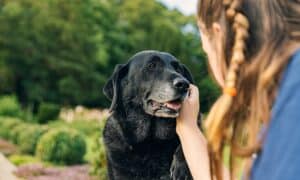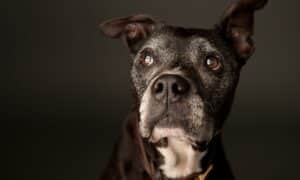“This post contains affiliate links, and I will be compensated if you make a purchase after clicking on my links.”
If, like me, you have a senior dog that’s starting to show signs of aging (though I would never tell her that!) you might be noticing behaviors that your dog didn’t exhibit in his younger years – slowing down, sleeping more, becoming less tolerant to younger dogs trying to play too much… My Molly, when she’s awake, is still as bright and smart as she always was. But, over 50% of dogs over ten years old begin to show some form of cognitive decline as they get older. This statistic had me wondering, can dogs get Alzheimer’s?
In this article from DoggedHealth.com, we learn what this cognitive decline entails, how you may be able to prevent it, and how to treat your senior dog in the event of a cognitive dysfunction.
Can Dogs Get Alzheimer’s?
Could your elderly dog have doggie Alzheimer’s? Is there such a thing? In fact there is a condition called cognitive dysfunction syndrome (CDS) that impacts some senior dogs. While not all senior dogs develop CDS, it is estimated that more than 50% of dogs over ten years of age show some signs of CDS.
Symptoms of CDS are similar to symptoms of Alzheimer’s in that they include disorientation, loss of memory, behavioral changes, and personality changes. If your dog has CDS he may seem confused or lost in familiar places, start soiling in the house, stop greeting familiar people, wander aimlessly or pace, develop a changed sleep-wake cycle, and/or become abnormally fearful or even aggressive.
Medical researchers believe these symptoms of CDS are caused by chemical and physical changes impacting the brains of some senior dogs. In examining the brains of dogs with CDS, researchers have found that impacted brains contain significant amounts of amyloid plaques. These plaques are essentially protein deposits that interfere with nerve cell functioning. It is also suspected that the accumulation of an enzyme called monoamine oxidase B (MAOB) plays a role in the development of CDS. Too much MAOB interferes with the brain’s ability to send signals to nerves.
To make a diagnosis of CDS your vet will perform a thorough physical and neurological examination of your dog. Your vet will also perform tests to rule out other diseases and conditions that may be causing your dog’s symptoms. For example, your vet will want to test your dog’s eyesight and look for the presence of other diseases or conditions including tumors and organ malfunctions that may cause your dog to experience discomfort, weakness or any of the other symptoms your dog is displaying.
The medication Anipryl® (selegiline hydrochloride) has been used to control symptoms and thus provide a better quality of life for some dogs suffering from CDS. Anipryl® is given orally to your dog in tablet form, and the usual dosage is one tablet each morning. Anipryl works by inhibiting MAOB, therefore allowing for better nerve cell signaling. Unfortunately, however, not all dogs seem to respond to the medication, and, as with any other medication, Anipryl® does have potential side effects and may not be appropriate for all dogs.
Studies have also suggested that supplementing your dog’s diet with omega-3 fatty acids and B vitamins can also help control the signs and symptoms of CDS. And there are specifically formulated anti-oxidant-rich diets on the market, such as Hill’s Prescription Diet® b/d® Canine dog food (available only by prescription), that are designed to help ward off age-related brain changes. You should, of course, discuss with your vet if any of these options are right for your dog.
Regardless of which treatment option is appropriate for your dog with CDS, there are simple things you can do to help make your dog more comfortable despite his symptoms. You should minimize stress and changes to his lifestyle. For example, stick to an established routine with your dog and, if possible, don’t move around furniture or make any other changes to the area in which your dog spends most of his time. While you should never let any dog run free and unattended, this is especially true for dogs with CDS who become easily disoriented and lost. Keep your dog on a leash or securely confined to his usual play area. Give your dog more opportunities to eliminate outside each day, and keep an eye on him to make sure he is able to negotiate his way around the house.
Read more here. Have you ever looked at your aging dog and wondered, can dogs get Alzheimer’s? Do you have a senior dog who’s personality or behavior has changed since his youth? Tell us your stories below!



















hotantiaging.Blogspot.com
Feb 21, 2014 at 12:39 am
Hey There. I found your blog using msn. This is an extremely well written article.
I will make sure to bookmark it and come back to read more of your useful information.
Thanks for the post. I will definitely return.